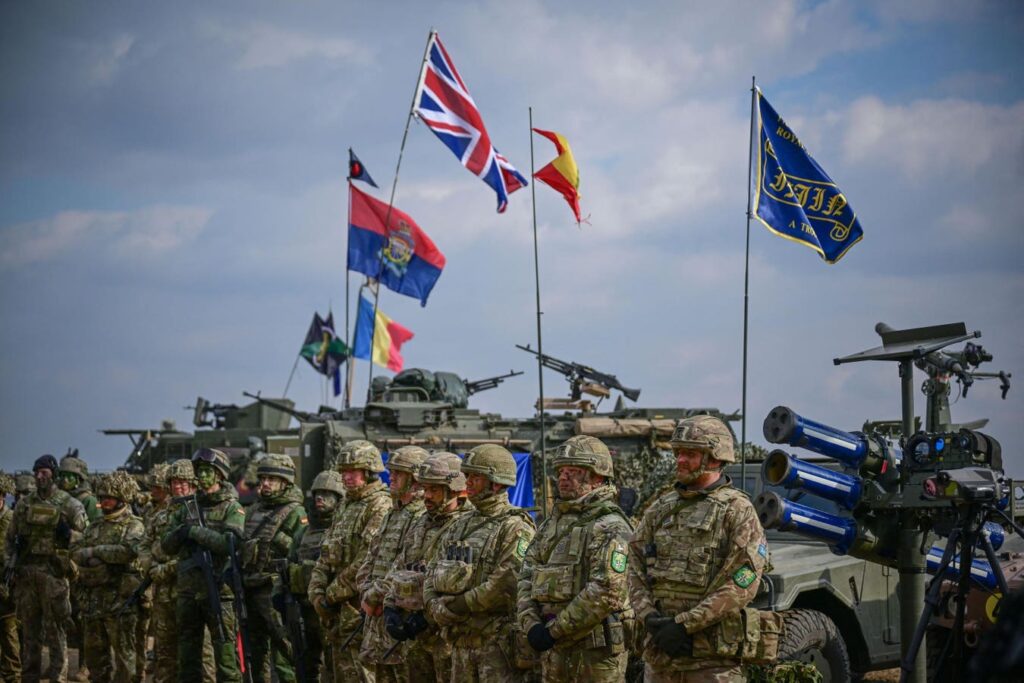NATO military forces during static display after “Exercise Steadfast Dart 2025” at the Smardan Training Area, in Smardan, south-eastern Romania, on February 19, 2025. The exercise is the first large-scale deployment of the ARF since its establishment past year and is aimed to test the deployable capabilities and procedures as well as the interoperability among the troop contributors and host nations. The exercise is set to demonstrate0 NATO’s ability to rapidly deploy forces from Europe to reinforce the defence of its eastern flank. This reinforcement will occur during a simulated emerging conflict scenario with a near-peer adversary, showing the ARF capability to conduct and sustain complex operations across thousands of kilometers and in any condition. Approximately 10.000 personnel from 9 Allies and including air, land, maritime and special operation forces will participate. STDT25 will be carried out in Romania, Bulgaria and Greece with the host nations’ support to demonstrate NATO’s responsiveness in delivering significant deterrence effects. Live capability demonstrations will be conducted including amphibious operations, live-fire air power and combined maneuvers across all domains. (Photo by Daniel MIHAILESCU / AFP) (Photo by DANIEL MIHAILESCU/AFP via Getty Images)
AFP via Getty Images
New data released by NATO Thursday exemplifies how profoundly the realities of foreign relations have changed over the course of the past three years. The military alliance announced that all 31 member nations with armed forces are expected to reach the shared goal of spending 2% of gross domestic product on defense this year. Agreed upon in 2014, the 2% threshold had been a source of contention within NATO over the years—including during U.S. President Donald Trump’s first term in office—and suffered setbacks as a result of the coronavirus pandemic.
However, with the invasion of Ukraine by Russia in 2022 and Trump back in office, the once elusive goal is now marked as realized by the alliance. As suspicion of Russia and China mounts in the West while military superpower the United States is pulling away from international engagements, Europe is undergoing a pivotal moment. This has been dubbed the “Zeitenwende” in Germany, meaning watershed moment or more literally “turning of the times”. As seen in NATO numbers, other European countries also seems to feel the need to up defense readiness, especially those in the continent’s Eastern and Northern parts.
This chart shows the number of 31 current NATO countries by percentage of real GDP spent on defense since 2014.
Statista
NATO numbers show that at the time of the 2% goal’s inception at the 2014 Wales summit, only three member nations were spending the recommended share of GDP on defense. These were the United States, the United Kingdom and Greece, which have all spent more than 2% consistently to this day. Maybe more gravely, only four additional nations at that point even spent above 1.5% of GDP on their militaries, namely France, Poland, Estonia and Croatia.
Over the years, these numbers crept up slowly to a preliminary high of 10 nations hitting the target and 16 in total above 1.5% in spending in 2020—still only a little over half of NATO’s members at the time. This decreased to 14 in 2021, before changing to 15 in 2022. Yet, from 2023 onwards, the tables have turned and even chronic laggards stepped up to their self-imposed demands. The biggest leaps in terms of spending between this year and last were done by Luxembourg, upping estimated military expenditure from 1.2% to 2.0% of GDP, as well as Belgium (up from 1.3%) and Slovenia and Spain (up from 1.4%) over the same time period. One non-European nation, Canada, took the leap up from 1.5% in 2024 to 2.0% in 2025, the same as Italy.
Fast Growth
Meanwhile, Demark had already increased military spending from 1.3% of GDP in 2022 to 2.0% in 2023, while Czechia did so between 2023 and 2024. The Scandinavian nation reached 3.2% of GDP in defense spending this year, more than doubling expenditure over the course of three years. It is therefore well on its way towards NATO’s new goal, set this year, of spending 3.5% of GDP on the military by 2035. Germany, whose turnaround from a nations reluctant on all things defense to a big reformer in the field has been most closely watched, hit 2.0% in 2024, up from 1.6% in 2023. The 2025 figure is still outstanding.
The biggest spender in NATO in relative terms is not the United States, which is spending 3.2% of GDP on its military in 2025, down from a recent high of 3.6% in 2020. Spending as a share of GDP is already higher in Estonia (3.4%), Norway (3.4%), Latvia (3.7%), Lithuania (4.0%) and Poland (4.5%) as especially Eastern and Northern European countries continue to grow defense spending fast. The figure also reached 2.8% in Finland, doubling in four years, around the same rate as Lithuania’s increase. Both Norway and Poland more than doubled their spending over the three years between 2022 and 2025.
Charted by Statista
